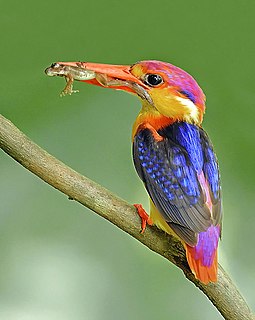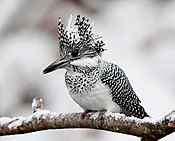
Kingfishers or Alcedinidae are a family of small to medium-sized, brightly colored birds in the order Coraciiformes. They have a cosmopolitan distribution, with most species found in the tropical regions of Africa, Asia, and Oceania. The family contains 114 species and is divided into three subfamilies and 19 genera. All kingfishers have large heads, long, sharp, pointed bills, short legs, and stubby tails. Most species have bright plumage with only small differences between the sexes. Most species are tropical in distribution, and a slight majority are found only in forests. They consume a wide range of prey usually caught by swooping down from a perch. While kingfishers are usually thought to live near rivers and eat fish, many species live away from water and eat small invertebrates. Like other members of their order, they nest in cavities, usually tunnels dug into the natural or artificial banks in the ground. Some kingfishers nest in arboreal termite nests. A few species, principally insular forms, are threatened with extinction. In Britain, the word "kingfisher" normally refers to the common kingfisher.

The belted kingfisher is a large, conspicuous water kingfisher. It is depicted on the 1986 series Canadian $5 note. All kingfishers were formerly placed in one family, Alcedinidae, but recent research suggests that this should be divided into three subfamilies.

The common kingfisher, also known as the Eurasian kingfisher and river kingfisher, is a small kingfisher with seven subspecies recognized within its wide distribution across Eurasia and North Africa. It is resident in much of its range, but migrates from areas where rivers freeze in winter.

The river kingfishers or pygmy kingfishers, subfamily Alcedininae, are one of the three subfamilies of kingfishers. The river kingfishers are widespread through Africa and east and south Asia as far as Australia, with one species, the common kingfisher also appearing in Europe and northern Asia. This group includes many kingfishers that actually dive for fish. The origin of the subfamily is thought to have been in Asia.

The pied kingfisher is a species of water kingfisher widely distributed across Africa and Asia. Originally described by Carl Linnaeus in 1758, it has five recognised subspecies. Its black and white plumage and crest, as well as its habit of hovering over clear lakes and rivers before diving for fish, make it distinctive. Males have a double band across the breast, while females have a single gorget that is often broken in the middle. They are usually found in pairs or small family groups. When perched, they often bob their head and flick up their tail.

The malachite kingfisher is a river kingfisher which is widely distributed in Africa south of the Sahara. It is largely resident except for seasonal climate-related movements.

The green kingfisher is a resident breeding bird which occurs from southern Texas in the United States south through Central and South America to central Argentina.

The half-collared kingfisher is a kingfisher in the subfamily Alcedininae that is found in southern and eastern Africa. It feeds almost exclusively on fish and frequents streams, rivers and larger bodies of water.

The American green kingfishers are the kingfisher genus Chloroceryle, which are native to tropical Central and South America, with one species extending north to south Texas.

Megaceryle is a genus of very large kingfishers. They have a wide distribution in the Americas, Africa and southeast Asia.

The Amazon kingfisher is a resident breeding kingfisher in the lowlands of the American tropics from southern Mexico south through Central America to northern Argentina.

The American pygmy kingfisher is a resident breeding kingfisher which occurs in the American tropics from southern Mexico south through Central America to western Ecuador, and then around the northern Andes cordillera in the east to central Bolivia and central Brazil. The species occupies the entire Amazon basin and the Tocantins River drainage adjacent in Pará state Brazil. It also occurs on Trinidad.

Pelargopsis is a genus of tree kingfishers that are resident in tropical south Asia from India and Sri Lanka to Indonesia.

The green-and-rufous kingfisher is a resident breeding bird in the lowlands of the American tropics from southeastern Nicaragua south to southern Brazil.

Actenoides is a genus of kingfishers in the subfamily Halcyoninae.

Alcedo is a genus of birds in the kingfisher subfamily Alcedininae. The genus was introduced by Carl Linnaeus in 1758 in the 10th edition of his Systema Naturae. The type species is the common kingfisher. Alcedo is the Latin for "kingfisher".

The oriental dwarf kingfisher, also known as the black-backed kingfisher or three-toed kingfisher, is a pocket-sized bird in the family Alcedinidae. This tropical kingfisher is a partial migrant that is endemic across much of the Indian Subcontinent and Southeast Asia. It resides in lowland forests, typically near streams or ponds, where it feeds upon insects, spiders, worms, crabs, fish, frogs, and lizards. This small bird is easily distinguishable from other birds in its range due to its red bill, yellow-orange underparts, lilac-rufous upperparts, and blue-black back.

The tree kingfishers or wood kingfishers, subfamily Halcyoninae, are the most numerous of the three subfamilies of birds in the kingfisher family, with around 70 species divided into 12 genera, including several species of kookaburras. The subfamily appears to have arisen in Indochina and Maritime Southeast Asia and then spread to many areas around the world. Tree kingfishers are widespread through Asia and Australasia, but also appear in Africa and the islands of the Pacific and Indian Oceans, using a range of habitats from tropical rainforest to open woodlands.

Corythornis is a genus of small African river kingfishers.

The dimorphic dwarf kingfisher is a species of bird in the family Alcedinidae that is endemic to the central and southern Philippines. Its natural habitat is subtropical or tropical moist lowland forests.






















